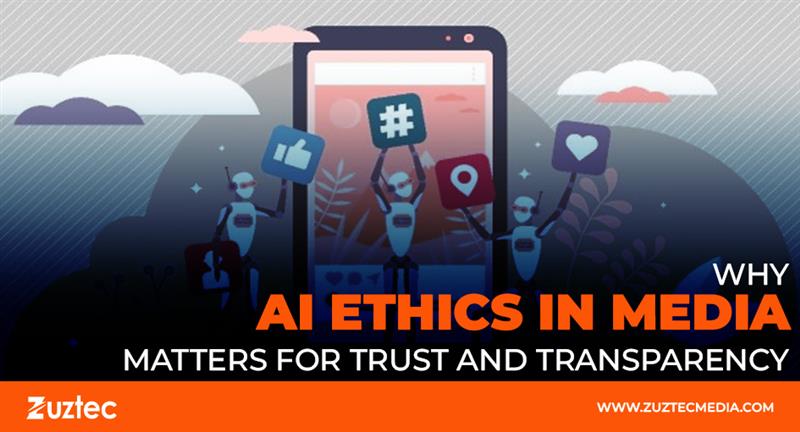
Why AI Ethics in Media Matters for Trust and Transparency
As artificial intelligence becomes more integrated into everyday life, its presence in the media world is growing fast. From news generation to video editing and personalized content, AI is transforming how stories are created, distributed, and consumed. While these advances offer exciting possibilities, they also raise serious ethical concerns. These ethics are now a major topic of discussion, affecting journalists, creators, tech developers, and audiences alike.
At the heart of this issue is a simple question: Can machines be trusted to act ethically when handling human information? The media has a powerful influence on society—it shapes opinions, spreads knowledge, and drives public conversations. When AI tools are used to automate content or make editorial decisions, questions of bias, accuracy, accountability, and fairness become unavoidable.
For example, AI algorithms that suggest news or social media posts can unintentionally promote misinformation or amplify harmful content. Deepfakes, powered by AI, can manipulate videos to mislead viewers. Even AI-written articles raise questions about truth, transparency, and authorship. Without proper ethical guidelines, these tools could do more harm than good.
This article explores the core concerns around AI ethics in media, including potential risks, the importance of human oversight, and the steps needed to ensure that technology enhances media without compromising truth or trust. As the line between human- and machine-driven media blurs, ethical responsibility must remain a top priority.
The Role of AI in Modern Media
Artificial intelligence is already shaping the media landscape in many ways. AI is used to write short news stories, recommend content, filter user comments, edit videos, and even generate voiceovers. These tools help reduce workloads, speed up production, and personalize content for users.
For example:
- Newsrooms use AI to generate basic reports on sports, finance, and weather.
- Streaming platforms use algorithms to suggest shows or music.
- Social media platforms rely on AI to moderate comments and flag harmful content.
These applications offer convenience and efficiency, but they also raise questions about accuracy, manipulation, and responsibility. If an AI tool spreads false information or promotes biased content, who is accountable—the platform, the developers, or the users?
Key Concerns with AI Ethics in Media
Several ethical issues arise when AI is involved in media processes:
- Bias and discrimination: AI learns from data, and if that data includes bias, the results will reflect it.
- Misinformation: AI-generated content can spread false narratives, especially when used to create fake news or deepfake videos.
- Lack of transparency: Often, users don’t know if content was created by a human or a machine, making it hard to judge its trustworthiness.
- Loss of human judgment: Relying too heavily on AI could remove the human context needed for sensitive stories, reducing empathy and ethical thinking.
These concerns highlight the need for careful oversight when using AI in media.
Why Human Oversight Still Matters
Even with advanced technology, human oversight is essential in media. AI can analyze data and automate tasks, but it lacks human values like empathy, ethics, and critical thinking.
Here’s why human input is still crucial:
- Context and sensitivity: Journalists and editors understand cultural nuances and ethical boundaries better than machines.
- Accountability: People must be responsible for decisions made using AI tools.
- Trust: Audiences are more likely to trust media that is transparent and overseen by humans.
Combining AI’s speed with human judgment creates a balanced and ethical approach to content creation and distribution.
Deepfakes and the Threat to Truth
One of the most serious concerns with AI in media is the rise of deepfakes. These are realistic but fake videos created by AI that can make someone appear to say or do something they never did.
The dangers of deepfakes include:
- Spreading false information
- Damaging reputations
- Manipulating public opinion
- Undermining trust in real footage
As deepfake technology becomes more accessible, the media must take steps to verify content and inform audiences when content has been altered by AI.
The Need for Clear Guidelines and Regulation
To manage AI ethics in media, clear rules and standards are necessary. Governments, tech companies, and media organizations all have a role to play.
Important steps include:
- Creating transparency policies: Letting users know when AI is used to generate or suggest content.
- Establishing accountability: Defining who is responsible when AI spreads false or harmful content.
- Building ethical AI: Designing systems that are fair, inclusive, and based on accurate data.
- Training staff: Helping media professionals understand how to use AI responsibly.
However, AI ethics in media is transforming the media industry in exciting and sometimes risky ways. While it brings speed and efficiency, it also introduces new ethical challenges that can’t be ignored. From biased algorithms to deepfake threats, the use of AI in media demands thoughtful regulation, ongoing human oversight, and a strong commitment to transparency.
Human-machine cooperation as well as cooperation between developers, creators, and legislators are key to the future of ethical media. The only way to guarantee that technology upholds the truth, fostering public confidence, and fortifying responsible communication as we continue to use AI in media is to keep ethics at the forefront of every choice.

